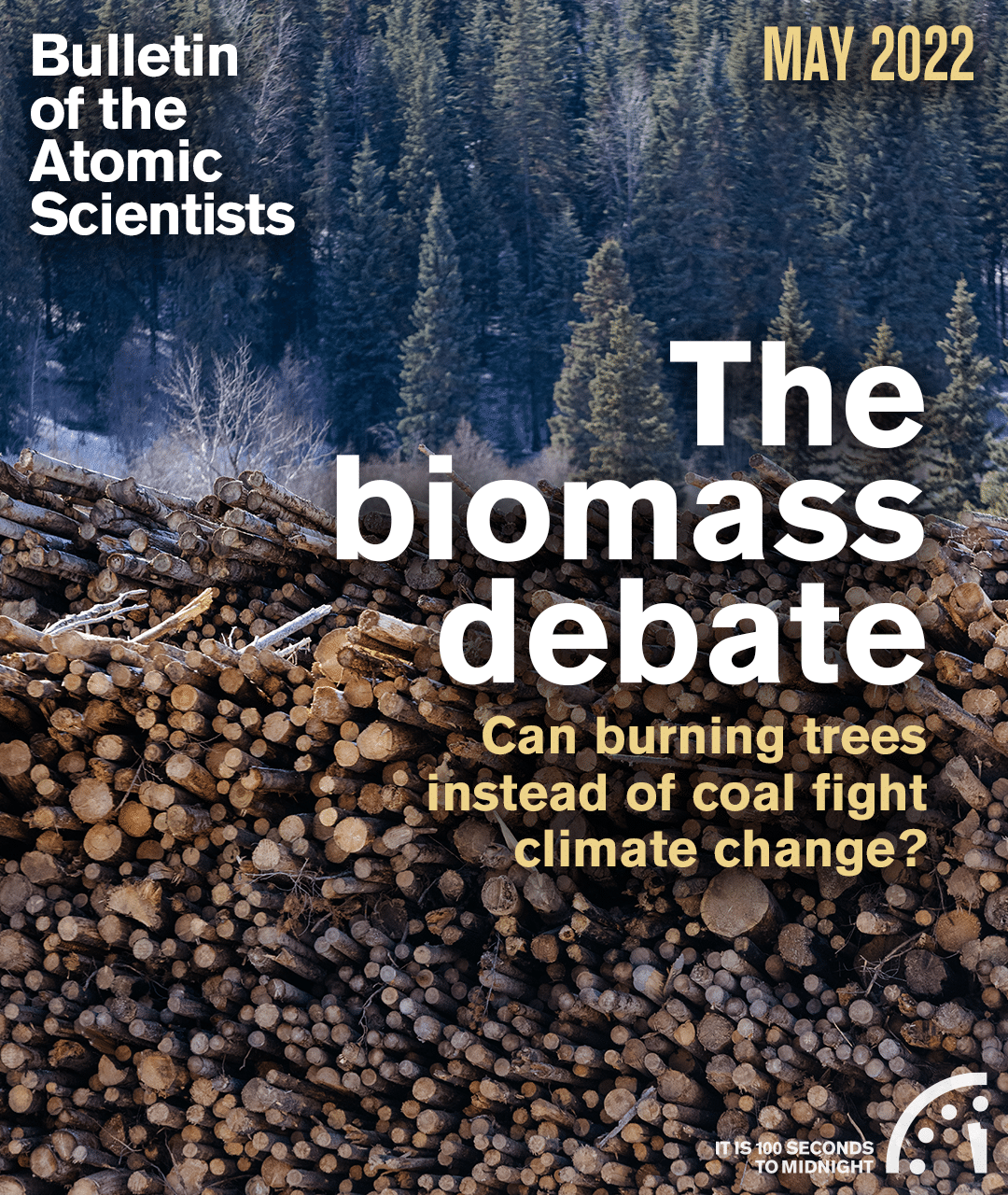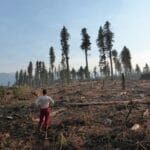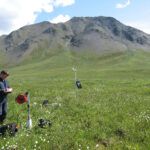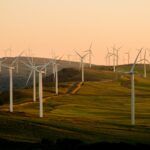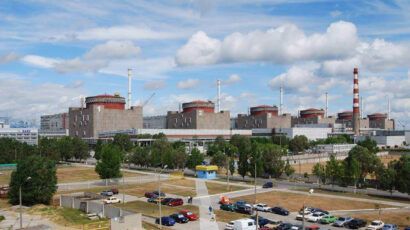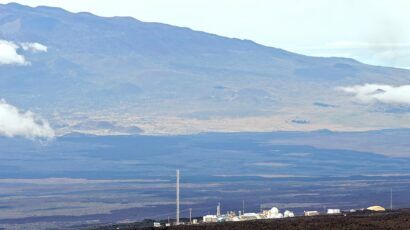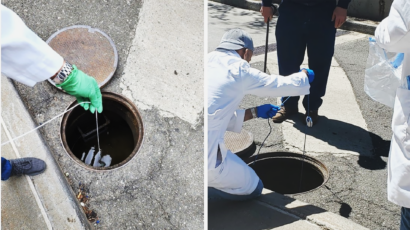Wood-burning: carbon hero or carbon villain? Q&A with forest modeling scientist Michael Ter-Mikaelian
By Dan Drollette Jr | May 10, 2022
Wood-burning: carbon hero or carbon villain? Q&A with forest modeling scientist Michael Ter-Mikaelian
By Dan Drollette Jr | May 10, 2022
Proponents of replacing fossil fuel with wood often envision vast plantations producing plant matter exclusively to fuel converted coal-fired power plants. They argue that the forests are renewable and restorable, and that tree restoration is the most effective solution to climate change to date. But others say this may not be the best way to deal with climate change and may even make the problem worse, because clear-cutting removes existing forest land—which has been actively removing carbon emissions from the atmosphere—for prolonged periods. Much of the promise of burning wood in place of fossil fuel hinges on the assumption that the trees will grow back quickly enough to take more carbon out of the atmosphere.
Researcher Michael Ter-Mikaelian, of the Ontario Forest Research Institute in Canada, talks with the Bulletin’s Dan Drollette Jr. about some of the problems to finding out if burning wood makes sense to fight climate change. He and his team discovered that much depends upon the original reference points, the conditions under which the trees were grown and harvested, the length of the time frame used for calculating carbon emissions and uptake, and what would have happened to the forest had it not been harvested.
(Editor’s note: This interview has been condensed and edited for brevity and clarity.)
Dan Drollette Jr.: You did a Journal of Forestry article analyzing the implications of burning biomass to generate power. Can you tell us what you found?
Michael Ter-Mikaelian: Yes, it was based upon an investigation we did a few years ago, on what happened when an Ontario coal-fired generating station was retrofitted to burning forest biomass. It was sort of an overview article, to rebut some of the myths around approaches to estimating the benefits of bioenergy. Prior to that, we published several papers. One, a fairly detailed one—again, with a lot of emphasis on the methodology—was essentially a background paper for retrofitting one of the Ontario coal-fired generating stations to forest biomass. There’s a common misconception that forest bioenergy is carbon neutral—that it doesn’t contribute any emissions to the atmosphere.
But it’s more complicated than that. Our latest results actually showed that while the burning of biomass can be very beneficial in terms of reducing emissions, its carbon reduction potential can vary tremendously depending on a number of things, such as the feedstock being used—and just as importantly, your initial reference point. For example, is the fuel you’re burning made up of mill residues—the waste generated when you turn a log into a wood product, such as a board? Because that’s a best-case situation: practically a free source of energy for local consumption for running mill processes, that replaces the use of fossil fuel-based energy.
And what are you comparing the burning of your biomass to? Are you comparing it to the burning of lignite, also known as “brown coal” or “soft coal”—a, soft, low-quality form of coal that is high in moisture and low in heat content, which means that this type of coal produces less heat per unit of carbon dioxide released, compared to other types of coal. Lignite is one of the dirtiest fossil fuels around—though scientists don’t like to use the word “dirty,” but instead say that lignite is associated with more carbon emissions.
Drollette: So that means that by choosing the dirtiest form of coal as your initial reference point, the burning of biomass is going to look pretty good.

Ter-Mikaelian: Well, I think a better way to put it is that it’s a good contrasting scenario, in which we’re using biomass to replace a fossil fuel that generates the most carbon emissions of any possible fossil fuel.
Lignite was actually what was being used in Ontario in that generating station that we studied. So depending on what energy source you replace, the benefits in terms of reducing emissions will be realized faster.
It’s all about your initial reference scenario: What are you replacing? And how was your replacement feedstock sourced? What are the parameters under which they were grown and harvested? Over what time frame?
Drollette: Do you think it’s more than a coincidence that there’s suddenly an interest in using wood pellets for fuel at the same time that the demand for wood pulp and paper is going down?
Ter-Mikaelian: Only in the sense that landowners who used to have their tree plantations designated for pulp and paper find there is no demand for it—and meanwhile, here’s a very convenient opportunity to sell their biomass to some Europeans who want to replace fossil fuel with something else.
It’s very good for both sides: One side needs [wood] fiber to burn in their generating stations, and the other side wants to sell that fiber because there is no longer as much demand for it as pulp and paper.
Drollette: And by fiber you mean biomass?
Ter-Mikaelian: Right.
Drollette: When people talk about biomass, do they usually mean grinding wood into pellets? Because it sounds like theoretically, the burning of biomass could refer to burning just about any form of vegetation—corn, sunflower stalks, grape vines, roots, weeds, soybeans—but in practice, it really seems to be about wood.
Ter-Mikaelian: Absolutely—although there’s a lot of work being done on corn ethanol and other crops.
But wood—trees—are where the emphasis is. I can’t really comment on these other areas, because my interest is in wood.
And that springs out of where I work. Ontario has a massive amount of forested lands; we have a “surplus” of trees, in the sense that we never even get close to cutting down the maximum harvestable amount as determined by the management plans for sustainable forests. Those maximums are never achieved, for a variety of reasons, but mainly due to the economics of timber harvesting—it’s just not worth chasing after those last trees.
So you know, we get to harvest only about 50 to 60 percent of what we could.
So there’s this so-called surplus of trees—for lack of a better term—that one could harvest, just standing there. And that’s how this discussion came to Ontario: “Hey, we have a surplus, and here’s a way to cut more.” We could turn our excess biomass into wood pellets and ship them to Europe to burn in their power plant furnaces.
Though it’s not good for us in reporting services.
Drollette: Please explain.
Ter-Mikaelian: It’s sort of a side story, but there are these rules that are used for counting up carbon emissions—rules that pertain to each country’s reporting of its carbon emissions for international agreements. So if we in Canada start cutting our trees and sending them as wood pellets to England, we could be on the hook for that burning biomass, so far as the reporting rules go. Our trees had removed that carbon from the atmosphere and locked it up in the form of wood, but the actual accounting benefits will go to Drax, Britain, because they are the ones who are considered to have replaced the burning of fossil fuel with the burning of wood.
This is not really about physics, but more of an accounting thing. Because in terms of physics—in terms of dealing with the sources of global warming—you know, whether you burn these wood pellets in one place or in another place doesn’t matter, that carbon you burned is still going into the atmosphere. But from the viewpoint of recording who cut what emissions, it’s really against our interest.
And the same goes for the US. The US ships their biomass to Europe, and then Europe gets all the benefits in terms of recording a reduction in carbon emissions.
At the same time, there’s been more and more impetus to just cut anything and grind it up into these wood pellets, going beyond just using scrap materials like millwaste. So, I think we gradually came to the worst feedstock—which is standing live trees.
Drollette: Why is that the worst-case scenario?
Ter-Mikaelian: Because after you harvest a standing live tree, it may grow back with proper regeneration efforts—but it will take a while before you get its carbon uptake to the level where it was prior to being harvested. Forests here in the north are not that quick-growing, so it may take 100 years before the tree that you cut down has resprouted and grown back to the point where it’s sequestering carbon from the atmosphere like it used to.
This is really not a good scenario: That tree would have continued to absorb carbon from the atmosphere, and you just chopped it down.
In a sense, you lose twice over. That volume of carbon is no longer locked away in that tree, and there’s a lost opportunity to sequester even more carbon during the 100 years it takes while the tree grows back.
That’s our reference scenario here in Ontario, anyway.
Drollette: Are things the same in other parts of North America? What if you’re dealing with fast-growing pines in the US South, where trees mature in 20 or 25 years?
Ter-Mikaelian: This is where the assumptions about the reference scenario can be critical. Landowners from the southeastern US will say: “These trees are standing, I gotta get some profits. And if I cannot make a profit by selling these trees to pulp and paper mills, and if I cannot sell these wood pellets to Europe, then I’ll find a buyer who will turn this forest into a parking lot.”
This argument is a bit of an exaggeration because nobody’s going to build a parking lot in the middle of nowhere, but there is a risk of deforestation due to the landowner not being able to make money from trees. So, the risk is real.
And so it comes down to: “What is the reference scenario here?” One may argue that if that southern tree plantation was not harvested, it would just sit there and continue to absorb carbon from the atmosphere. But others counter that argument by saying that it’s not going to just sit there—that forest will get harvested one way or another. And if it’s harvested, and the land use changes, then nothing’s being planted to replace it and there are no longer trees there to take carbon out of the air.
So this is one of the points of the debate. What is the right reference scenario?
Drollette: And all this assumes that the goal is long-term sustainable forestry, as opposed to a sort of hit-and-run, quick profit, extractive “tree mining,” for lack of a better way to put it?
Ter-Mikaelian: Right. In terms of reducing carbon emissions, the proper way is to manage the forests—your biomass—sustainably. Which means harvest a little bit, protect the trees from natural disturbances as much as you can, and properly regenerate the harvested part. That way, you’re renewing your forest faster, and steadily keeping your trees in a situation where they’re taking up as much carbon as they can, for as long as they can.
And you should turn what you harvest into finished wood products that stay around longer, thereby keeping that carbon locked up. You want to get as much as you can out of each round of the carbon cycle. So instead of burning the trees or turning them into pulp, I’m talking about making those trees into sawn wood for making things—like lumber, furniture, and so forth, things that can be used in housing, construction, and so on, for years or even decades. I’ve even heard of lumber used in place of steel for making multi-story buildings: skyscrapers. Under that kind of approach, the wood is used in the form of a product that lasts longer and maximizes the time that the carbon is safely locked away—it doesn’t end up in the atmosphere. Instead, we’d be investing that wood fiber—that biomass—into wood products with a long shelf life, which leads to much bigger carbon emission reductions than what happens when you turn that fiber into wood pellets for bioenergy. You’re maximizing carbon storage.
Drollette: Sounds like a pretty cut-and-dried case.
Ter-Mikaelian: As a scientist, I don’t take sides. My job is to estimate the carbon emissions coming from certain scenarios and compare them.
There are a lot of decisions that have to be made by society, because carbon is only one aspect to consider when you’re making the decision about whether to harvest forests or not. You also have to consider the other values of the forest—wildlife habitat, protection of the aquifer, hunting, recreation, jobs, aesthetic values, and so on and so forth. And sometimes that means leaving some harvest residue behind, in order to benefit the wildlife or protect the water supply. And those are societal decisions. I just provide the data from the models.
Drollette: I mean, a cut-and-dried case in terms of reducing carbon emissions.
Ter-Mikaelian: Well, there is a school of thought—supported by some scientists—that while the burning of biomass may result in more carbon emissions, it is still an alternative to burning fossil fuels.
And it’s arguably a good alternative—maybe not in the short run, because you generate more emissions—but in the long run. Because you are not dragging additional fossilized carbon out of the ground and adding it to the existing mix. Instead, by burning wood, you’re dealing with the current biogenic carbon cycle.
So in the long run, the burning of biomass could still be a better alternative, no matter how many additional emissions you generate in the short term.
It all depends on the time scale you’re using. Some people advocate that there should be no subsidies for any type of biomass project that does not result in quick emission reductions. And they point to the Paris Agreement and the fact that we have to do something by 2050. Not by 2100, not by 2200, we have to do something now, due to the need to avoid triggering the built-in tipping points of climate change.
But then there is an equally strong and vocal group—which includes a lot of scientists—that counter that it doesn’t matter what happens in 2050, we have to think longer term; the burning of biomass in place of fossil fuel could be bad for 2050, but good by 2100. That’s what we have here.
I don’t want to take sides. As I said, I see my job as providing ammunition to the decision makers, in the broadest sense of the term. Because it’s not just policy people that must make these choices, but these things must be decided by society as a whole.
Together, we make the world safer.
The Bulletin elevates expert voices above the noise. But as an independent nonprofit organization, our operations depend on the support of readers like you. Help us continue to deliver quality journalism that holds leaders accountable. Your support of our work at any level is important. In return, we promise our coverage will be understandable, influential, vigilant, solution-oriented, and fair-minded. Together we can make a difference.
Keywords: Drax, bioenergy, biomass, carbon dioxide, climate change, forestry, sustainable forestry, wood combustion
Topics: Analysis, Climate Change

